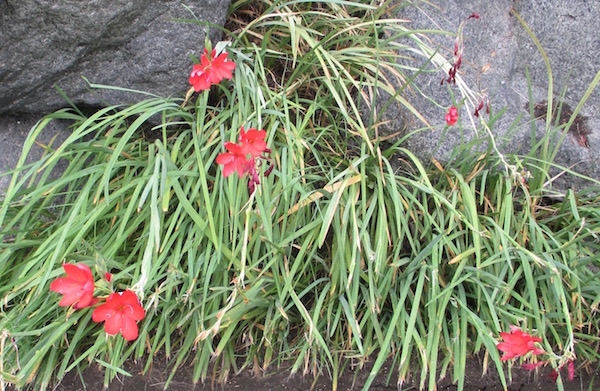| The Kaffir Lily, also called Cape Lily, Crimson Flag, Crimson Corn Flag, Crimson River-Lily, and Crimson Flag Lily, was named Schizostylis coccinea from 1864 til 1996, when it was moved to genus Hesperantha. Most gardeners still call it Schizostylis. It is the only Hesperantha species (over 80 exist) that grows from plump creeping rootstocks rather than corms. All Hesperantha are sub-Saharan African, some in winter-rainfall areas, others in summer-rainfall regions. The least rarely cultivated of them is Hesperantha coccinea. In the wild, it is seen in streams and marshes, growing in water --unlike the other species. That is why it lacks corms. Its leaves are slender and grassy, its flowers pink or red, appearing --in Seattle-- from July into October or even November or December. Its foliage can be virtually evergreen. Its fleshy rootstock can spread to make a dense, even unwelcomely extensive patch. It can make seedlings in gardens. It is naturalized in SW England and Wales, besides New Zealand. |
| Gardeners like Crimson Flag because it is easily grown in ordinary or even soggy garden soil; its foliage is not prone to mites as in Crocrosmia; the plants do not need staking as do many Gladiolus; its flowers are attractive as is, or excellent as florists' cut flowers; red, pink and palest pink to (rarely) white cultivars exist; it makes a good container plant; it tolerates frost though severe freezes zap it; it can even be used as a houseplant if proper care is taken. Whether inside or out, do not let it go too dry; it is thirsty. |
| Many dozens of cultivars have been named. Edelweiss perennials nursery of Canby, Oregon, sells 8 cultivars mail-order. |
Crimson Flag is likely edible to humans. I have not tried it yet. Some of its cousins are reported edible, as follows.
|
| Hesperantha Baurii Baker |
A common, widespread, species in summer-rainfall grassland from 500 to 2,000m elevation. Flowers mid to late summer; deep pink to almost magenta. The corms of this species are the most widely consumed. A 1917 PhD. thesis stated that "children beg the bulbs from adults to eat." (A contribution to the Flora of the Leribe Plateau and Environs by E.P. Phillips in Annals of the South African Museum XVI Part 1 June 1917)
|
| Hesperantha Petitiana (A. Rich.) Baker |
| = Ixia Petitiana A. Rich. |
A tropical African species, from E Zimbabwe to Ethiopia & Cameroon. Flowers mauve-pink to almost white. Food Plants International lists this as edible, but with no details.
|
| Hesperantha radiata (Jacq.) Ker Gawl. |
| = Ixia radiata Jacq. |
Grows in both winter and summer rain areas. Flowers scented, white to cream. Corms eaten.
|
| Hesperantha species in general |
| 1) Food from the Veld: Edible Wild Plants of Southern Africa by Francis William Fox & Marion Emma Norwood Young 1982: "Jacot Guillarmod (personal communication, 1966) says that the corms of these plants are eaten raw in Lesotho." |
2) Systematics, biology and evolution of some South African taxa: proceedings of a symposium of the Southern African Society of Plant Taxonomists held at Grahamstown on 18 January 1990: "Leaves of Hesperantha and Watsonia are also used as a vegetable and flavoring in Namaqualand." (by Peter Goldblatt & Heidrun E.K. Hartmann)
|
Eight other genera in same tribe as Hesperantha that include species reported to be eaten by people, are: Babiana, Chasmanthe, Crocus, Dierama, Ixia, Romulea, Sparaxis, and Tritonia. Five other genera in same tribe as Hesperantha for which I have yet to find species reported to be eaten by people, are: Afrocrocus, Duthieastrum, Geissorhiza, Radinosiphon, and Syringodea.
Back |

Hesperantha coccinea; photo by ALJ
|

Hesperantha coccinea; photo by ALJ
|

